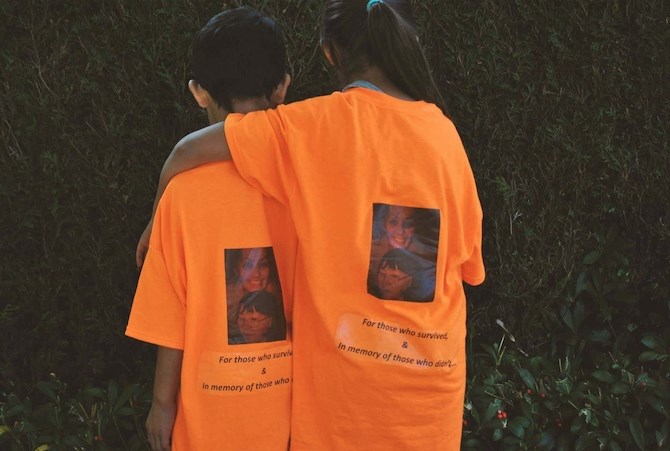
Students and teachers in many school districts were encouraged to wear orange shirts as a way to acknowledge the atrocities that happened in residential schools.
Image Credit: Kelsie Kilawna, Local Journalism Initiative
June 06, 2021 - 3:29 PM
In the aftermath of the shocking news of 215 children’s bodies being discovered in a mass burial site at the Kamloops Indian Residential School, IndigiNews spoke with educators to gather resources on how to engage with children and youth.
“Having conversations about the deaths of children at residential school with our young children is definitely not easy,” says Katie Lonsdale, a Grade One and Two educator at Qwam Qwum Stuwixwulh School on unceded Snuneymuxw territory.
Qwam Qwum is is co-governed and operated between the Snuneymuxw First Nation and Nanaimo Ladysmith Public Schools.
In Lonsdale’s classroom, which includes both Indigenous and non-Indigenous children, they have been introduced to Indian Residential Schools through the books Phyllis’s Orange Shirt by Phyllis Webstad and When We Were Alone by David A. Robinson and Julie Flett.
Lonsdale’s class also participates in Orange Shirt Day, which is inspired by Webstad’s experience at residential school at St. Joseph Mission in Williams Lake.
The Orange Shirt Day Society has a teacher resource section to guide educators on readings and teachings in the classroom.
Anishinaabe educator Claire Shannon-Akiwenzie, who currently teaches grade six, suggested the picture books Shi-shi-etko and Shin-chi’s Canoe by Nicola I. Campbell. Shannon-Akiwenzie also suggested I Am Not a Number by Jenny Kay Dupuis and Kathy Kacer, and When I Was Eight by Gabrielle Grimard.
Shannon-Akiwenzie, who is a graduate of the Indigenous Teacher Education Program (NITEP) at the University of British Columbia, also suggests the teacher resources Gladys We Never Knew and Project of the Heart.
“You might want to also consider buying resources from Indigenous publishing companies and bookstores like Strong Nations, GoodMinds, Theytus Books, Kegedonce Press, Massy Books and Iron Dog Books,” she says.
Shannon-Akiwenzie also points to the First Nations Education Steering Committee and their resources for speaking with children about residential schools.
The National Centre for Truth and Reconciliation has a tool for educators on age appropriate books to read in class. A Stranger At Home: A True Story and Fatty Legs: A True Story, both by Christy Jordan-Fenton, Margaret Pokiak-Fenton, and illustrated by Liz Amini-Holmes, are suggested as resources.
IndigiNews also reached out to the B.C. Ministry of Education to ask how they will be supporting educators following the recent news, but did not receive a response in time for publication of this story.
Support for survivors and their families is available. Call the Indian Residential School Survivors Society at 1-800-721-0066, 1-866-925-4419 for the 24-7 crisis line. The KUU-US Crisis Line Society also offers 24-7 support at 250-723-4050 for adults, 250-723-2040 for youth, or toll free at 1-800-588-8717.
— This story was originally published by The Discourse and IndigiNews.
News from © iNFOnews, 2021